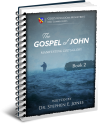Latest Posts
View the latest posts in an easy-to-read list format, with filtering options.

Jesus manifested God's glory through 8 miraculous signs in the gospel of John. These are a revelation of the feast of tabernacles.
Category - Bible Commentaries

In John 6:9 a young boy offered to share his lunch with Jesus and His disciples. The disciples, being rational adults, said, “what are these for so many people?” But the boy had no such thought, for he only saw the need and stepped forward to do what he could. In his innocence and purity, it did not occur to him that this looked ridiculous or unreasonable.
God had chosen the boy to provide the means for a notable miracle which would feed a great multitude. From Jesus’ point of view, He knew that His heavenly Father would always provide what was needed at the moment and that it would always be sufficient.
Philip had suggested that 200 denarii worth of bread, even if it could be purchased, was insufficient to feed all of them with even a little portion (John 6:7). The number 200 is the biblical number of insufficiency. The disciples were being taught a new lesson that when God provides something, however small, it is never insufficient. It is not that God provides too little but that our flesh thinks it is insufficient.
I have pondered this over the years, for there have been many occasions where I complained that God’s provision was lacking. He showed me that my desires—even my good desires—needed to be subjected to His will and to the timing in His plan. Our desires to do good or (in my case) the desire to do more to minister to others must be subordinated to the desire and will of God. The multitudes in the world who (as I believe) need to hear the word that He has deposited in me must wait for the appointed time of the Father.
Likewise, there are times when God provides a little and we are to have the faith to multiply it. This principle is not limited to food. I recall hearing how some people sent boxes of clothing to Sudan during their civil war a few years ago. As they began to distribute the clothing to the multitude, they did not run out of clothing until all had received what they needed.
Therefore, the lesson in the fourth sign should be taken seriously by all of us who claim to be Christ’s disciples. Though our natural tendency is to think that our provision is insufficient, our faith is being built one spiritual brick after another. I, for one, expect to see such multiplication in the time ahead. In fact, it has already begun on a small scale, and every time it occurs, my faith increases.
John 6:10 says,
10 Jesus said, “Have the people sit down.” Now there was much grass in the place. So the men sat down, in number about five thousand.
Matt. 14:19 says that He was “ordering the people to sit down on the grass…” Mark 6:39 says, “He commanded them to sit down by groups on the green grass.” He says they were put into “groups of hundreds and of fifties” (Mark 6:40). Luke mentions no grass but tells us that Jesus said, “Have them sit down to eat in groups of about fifty each” (Luke 9:14).
The grass represents flesh, as we read in Isaiah 40:6-8,
6 A voice says, “Call out.” Then he answered, “What shall I call out?” All flesh is grass, and all its loveliness is like the flower of the field. 7 The grass withers, the flower fades, when the breath of the Lord blows upon it; surely the people are grass. 8 The grass withers, the flower fades, but the word of our God stands forever.
This passage is quoted in 1 Peter 1:23-25 in reference to man’s mortality, which is the reason we need to be begotten by the Holy Spirit. So when the people were told to sit down on the grass, Jesus was identifying them with grass and pointing out their mortal condition. As such, this miracle was to teach them and us the purpose of Passover and the wave-sheaf offering, which they had just observed. It is about death and resurrection.
The 5,000 were divided in groups of 50 or 100. That would be either 50 groups of 100 each, or 100 groups of 50 each. This was probably how the disciples were able to count the people as well. It appears that for prophetic purposes they counted only the men, although there were many women and children among them as well (Matt. 14:21).
The number 50 is the number of Pentecost and Jubilee; 100 means fullness or completeness. It suggests not only the outpouring of the Holy Spirit but the completed work of Christ, where all sin (“debt”) is cancelled and everyone returns to his inheritance. In other words, the miracle pictures the transformation of all flesh from mortal “grass” to becoming the living word, which “stands forever.”
This was the underlying meaning of Passover, accomplished by Christ’s death on the cross as “the Lamb of God who takes away the sin of the world” (John 1:29).
John 6:11-13 continues,
11 Jesus therefore took the loaves; and having given thanks, He distributed to those who were seated; likewise also of the fish as much as they wanted. 12 When they were filled, He said to His disciples, “Gather up the leftover fragments that nothing may be lost.” 13 And so they gathered them up, and filled twelve baskets with fragments from the five barley loaves which were left over by those who had eaten.
Why was Jesus so concerned about the leftover fragments? The meaning is given later in the chapter when the miracle is explained in the commentary. John 6:39, 40 says,
39 This is the will of Him who sent Me, that of all that He has given Me I lose nothing, but raise it up on the third day. 40 For this is the will of My Father, that everyone who beholds the Son and believes in Him, may have eternal life; and I Myself will raise him up on the last day.
This is repeated again in John 6:44, “and I will raise him up on the last day.”
In other words, the “fragments” of the bread represented the mortal body that was fragmented in death. Gathering up those fragments prophesied of the resurrection from the dead. This is perhaps best pictured in Ezekiel 37, where the prophet speaks of the valley of dry bones. This was the house of Israel, which had been scattered by the Assyrians. As dry bones, they say, “Our bones are dried up, and our hope has perished. We are completely cut off” (Ezek. 37:11).
The prophet then was told to speak to the dry bones, and “the bones came together, bone to its bone” (Ezek. 37:7). This was pictured as a resurrection from the dead. This resurrection was obtained for all of us through the resurrection of Christ Himself on the day of the wave-sheaf offering on the third day.
So when the disciples gathered up the leftover fragments, they filled 12 baskets full. The number 12 is the biblical number of divine government. Thus, Rev. 20:6 says of the resurrected ones,
6 Blessed and holy is the one who has a part in the first resurrection; over these the second death has no power, but they will be priests of God and of Christ and will reign with Him for a thousand years.
The purpose of the first resurrection is to gather up the fragments of the overcomers who have died throughout past generations, so that they may “reign with Him for a thousand years.” This is a limited resurrection (Rev. 20:5). Not even all believers are raised at that time, for we find believers being raised to life later in the general resurrection (John 5:28, 29).
When Elijah hid from King Ahab for three years, most of that time was spent at a widow’s house in “Zarephath, which belongs to Sidon” 1 Kings 17:9). There we read how he multiplied the bread (flour) and the oil to provide for her during the time of drought and famine. 1 Kings 17:14 says,
14 For thus says the Lord God of Israel, “The bowl of flour shall not be exhausted, nor shall the jar of oil be empty, until the day that the Lord sends rain on the face of the earth.”
Likewise, his successor, Elisha, also performed a miracle of multiplying bread. 2 Kings 4:42-44 says,
42 Now a man came from Baal-shalisha and brought the man of God bread of the first fruits, twenty loaves of barley and fresh ears of grain in his sack. And he said, “Give them to the people that they may eat.” 43 His attendant said, “What, shall I set this before a hundred men?” But he said, “Give them to the people that they may eat, for thus says the Lord, ‘They shall eat and have some left over’.” 44 So he set it before them, and they ate and had some left over, according to the word of the Lord.
The man from Baal-shalisha was like the boy with the five barley loaves. Both brought barley, signifying the wave-sheaf offering of the first fruits of barley. The doubting attendant was like the disciples who questioned Jesus’ sanity. But in both cases the crowd ate to the full and had leftovers. All of these stories (Elijah, Elisha, Jesus) give us the revelation of provision needed until the day of resurrection.
John 6:14 says,
14 Therefore when the people saw the sign which He had performed, they said, “This is of a truth the Prophet who is to come into the world.”
The “prophet” that the people were expecting was either Elijah, Elisha, or Moses (John 1:21). Moses fed the people with manna, while Elijah fed the widow woman, and Elisha fed the school of prophets. The fourth sign that Jesus performed identified Him with all three of these prophets from the past and fulfilled the expectations of the people from Mal. 4:4, 5.
But Luke 9:18-20 says,
18 … He questioned them, saying, “Who do the multitudes say that I am?” 19 They answered and said, “John the Baptist, and others say Elijah; but others, that one of the prophets of old has risen again.” 20 And He said to them, “But who do you say that I am?” And Peter answered and said, “The Christ of God.”
It appears, then, that people were discussing among themselves which of the prophets had arisen. The one that stands out, of course, is Elijah, although it is likely that others thought He was either Moses (from Deut. 18:18, 19) or Elisha (2 Kings 4:42-44).
The people then wanted to make Jesus king. John 6:15 says,
15 So Jesus, perceiving that they were intending to come and take Him by force to make Him king, withdrew again to the mountain by Himself alone.
In the big picture, this sign presents us with Christ’s death and resurrection. What follows, of course, is His ascension to heaven, where He was to make intercession for us until His return (Rom. 8:34). So we see that Jesus escaped from those who wanted to crown Him king, and He withdrew to a mountain (John 6:15).
What follows is the fifth sign, which is really a continuation of the fourth sign, in that it prophesies of Christ’s second coming at the time of the feast of Tabernacles.